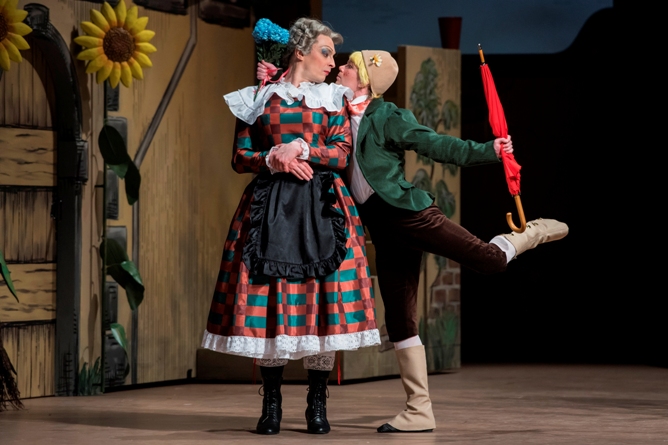 For the very first time in its history, the Czech National Ballet will perform Sir Frederick Ashton’s choreography La Fille mal gardée. The masterpiece, whose productions have featured the world’s very finest dancers, has to date been staged by more than 35 companies, including the Royal Ballet in London, the Paris Opera, the Bolshoi Theatre in Moscow, the American Ballet, the Boston Ballet and the National Ballet of Canada.
For the very first time in its history, the Czech National Ballet will perform Sir Frederick Ashton’s choreography La Fille mal gardée. The masterpiece, whose productions have featured the world’s very finest dancers, has to date been staged by more than 35 companies, including the Royal Ballet in London, the Paris Opera, the Bolshoi Theatre in Moscow, the American Ballet, the Boston Ballet and the National Ballet of Canada.
La Fille mal gardée (The Wayward Daughter) is a truly unique work, as its original version ranks among the oldest ballets preserved up to the present day. Taking place in a pastoral setting inspired by Ashton’s love for the Suffolk countryside, the cartoon-like set design, featuring maypoles and dancing hens, creates a wonderful spring atmosphere full of sunshine.
La Fille mal gardée is one of Ashton’s most virtuoso choreographies, difficult in the series of energetic pas de deux and solos that express the youthful passion of Lise and Colas.
The ballet, originally titled
Le ballet de la paille, ou
Il n'est qu'un pas du mal au bien (The Ballet of the Straw, or There is Only One Step from Bad to Good) was first presented at the Grand Théâtre de Bordeaux on 1 July 1789, a mere two weeks prior to the outbreak of the French Revolution. It was a creation of
Jean Dauberval (1742–1806), one of the greatest choreographers of his time, a pupil of the renowned dance reformer
Jean-Georges Noverre. The lead role was portrayed by Théodore Dauberval, the choreographer’s wife. In the ballet d’action, inspired by his teacher, Dauberval enriched the heroic subject with comedic elements. The work does not feature aristocrats, kings and gods, as was conventional in ballets at the time, but ordinary people, and neither does it include supernatural beings, as would become the case of Romantic ballet in the first half of the 19th century.
The story is set in a village. Widow Simone tries to prevent her pretty daughter Lise from marring Colas, a smart yet poor fellow, as she would like her to wed the dim-witted, yet extremely rich, Alain, the son of a landowner. Containing both humorous and lyrical scenes, the ballet’s story is similar to that of Bedřich Smetana’s opera The Bartered Bride. In line with an old tradition, the comic role of Mama Simone is danced by a man.
Dauberval’s choreography was an astounding success. Two years after its premiere in Bordeaux, the work was staged in London, and subsequently all over Europe, under the titles
Le Ballet de la paille and
La Fille mal gardée. In 1885, its revival, created by Marius Petipa and Lev Ivanov, premiered as La Précaution inutile in Russia.
Sir Frederick Ashton’s Royal Ballet production of
La Fille mal gardée has become a celebrated classic of the ballet repertoire. Since its opening night in 1960, his version, to the original music arranged by John Lanchbery, has been the most popular English-style ballet worldwide. Ashton’s feted choreography will now finally be staged at the National Theatre in Prague.
„I have often been asked why I chose to do La File mal gardée instead of putting my ideas into an entirely new ballet. Of course I could have taken the subject and brought it up to date. Lise could have been Tottie, a farmer‘s daughter refusing to work, dressed and made up as to her idea of a film star, making assignations with the American airmen from a nearby station, returning late to the farm, smelling of drink and in a giddy trance – a blue-jeans Beatnik young farmer strumming his guitar over the fence when Mum had to put her to work and distracting her continually – and in the end, her taste for luxury and ease getting the better of her, rejecting the rock-‘n‘-roll young man and marrying the soft-ie‘s rich father! It happened, however, that at the time I was reading Dorothy Wordsworth‘s Journals and I was swept by a longing for the country of the late 18th and early 19th century: the country of today seems a poor noisy thing by comparison. There has always been a cosy side to my nature which is reflected in the kind of decors I make for myself in my home life and in the objects around me. There exists in my imagination a life in the country of eternally late spring, a leafy pastorale of perpetual sunshine and the humming of bees – the suspended stillness of a Constable landscape of my beloved Suffolk, luminous and calm.“ (Frederick Ashton, The Dancing Times, 1960)
Source: National Theatre




 For the very first time in its history, the Czech National Ballet will perform Sir Frederick Ashton’s choreography La Fille mal gardée. The masterpiece, whose productions have featured the world’s very finest dancers, has to date been staged by more than 35 companies, including the Royal Ballet in London, the Paris Opera, the Bolshoi Theatre in Moscow, the American Ballet, the Boston Ballet and the National Ballet of Canada.
For the very first time in its history, the Czech National Ballet will perform Sir Frederick Ashton’s choreography La Fille mal gardée. The masterpiece, whose productions have featured the world’s very finest dancers, has to date been staged by more than 35 companies, including the Royal Ballet in London, the Paris Opera, the Bolshoi Theatre in Moscow, the American Ballet, the Boston Ballet and the National Ballet of Canada.